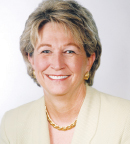Two years ago, Rick Avila, MS, Chief Executive Officer (CEO) of Accumetra, LLC, was using rolls of Scotch tape as a research tool. The Scotch tape was a phantom, or reference object, and his company was working with computed tomography (CT) lung screening sites around the world to determine the best CT scanners and scanner settings to detect and measure small lung nodules.
Clinical sites taking part in the project could submit scans of identical rolls of Scotch tape to a cloud-based website and, within minutes, receive feedback on the quality of their CT scans and the accuracy of measurements taken with their scans. The sites could then recalibrate their scanners if necessary and send a new scan back to Accumetra for verification of proper quantitative performance.

With enough image quality, we could one day auto-detect 3-mm lung nodules at annual screenings and highlight only those confirmed to be growing at a malignant rate.— Rick Avila, MS
Tweet this quote
That was the first step. Next, working on a pilot project with the Quantitative Imaging Biomarkers Alliance (QIBA) organized by the Radiological Society of North America (RSNA) and with the support of the Prevent Cancer Foundation, Accumetra distributed a much more sophisticated phantom, called the CTLX1, to 65 screening sites around the world. The new phantom is especially useful for calibrating scanners that must detect and measure tiny objects—a 6-mm lung nodule, for instance.
In screening for lung nodules, “accuracy of measurement is critical,” said Mr. Avila, who reported on advances with the new phantom at the Prevent Cancer Foundation’s 15th Annual Quantitative Imaging Workshop. The CTLX1 phantom allows sites to verify that scans are being acquired with high resolution, and it is the first quantitative image quality phantom to perform this verification throughout the full CT scanner field of view—the center of the lung, the periphery, and midway between. This is important because 60% of lung cancers form in the periphery. Catching them at that early stage, when the disease is very small in size, can save lives.
The progression from Scotch tape to the CTLX1 phantom is a landmark in the effort to improve the quality of measurement—and the detection of early lung disease—with quantitative imaging. “We can now specify the needed image characteristics in regard to resolution, noise, and spatial warping to reach our goals,” Mr. Avila said. “With enough image quality, we could one day auto-detect 3-mm lung nodules at annual screenings and highlight only those confirmed to be growing at a malignant rate.”

James L. Mulshine, MD
This was not the year’s only positive news in lung screening, noted James L. Mulshine, MD, of Rush University, as he opened the workshop. The results of the large randomized NELSON trial in Europe showed that volumetric low-dose CT screening in high-risk patients reduced lung cancer deaths by 26% in men and up to 61% in women.
“The year has brought a remarkable alignment of positive findings,” Dr. Mulshine said in an interview. “Not too many years ago, the idea that a randomized trial could demonstrate more benefits than risks for [low-dose] CT screening was considered unrealistic. So to see the confirmatory results of the NELSON trial plus the development and rapid dissemination of tools to ensure the quality of screening is remarkable. We now have implementable solutions.”
Dr. Mulshine has worked with the Foundation since 2004 to organize the annual quantitative imaging workshops, which provide a forum for exchanging ideas about early disease management as well as policy and advocacy for early lung cancer, chronic obstructive pulmonary disease, and cardiovascular screening. The most recent workshop included sessions on various developments in low-dose CT screening, including an emerging infrastructure to support screening sites; the potential of large amounts of data from low-dose CT screening for deep learning applications in the diagnosis and management of early disease; and efforts to improve access to screening for all eligible patients.
Support for Screening Sites
The pilot project that began with Scotch tape has led to an RSNA/QIBA initiative aimed at automated and efficient support for all low-dose CT screening sites. The QIBA conformance certification service offers clinical sites feedback on their scans, as in the pilot project, feedback on the performance of their nodule analysis software, and certification of conformance with the QIBA CT Small Lung Nodule Volume Assessment and Monitoring in Low Dose Screening Profile (http://qibawiki.rsna.org/index.php/Profiles). Conformance certification comes with the listing of an institution as a QIBA conformance–certified site and the ability to use an institution-specific QIBA conformance certification mark.
QUANTITATIVE IMAGING WORKSHOP XV
- Theme: Lung Cancer, COPD, and Cardiovascular Disease—Quality Is a Gateway to Deep Learning
- Held: November 5–6, 2018, Alexandria, Virginia
- More information: preventcancer.org
Importantly, Mr. Avila said, clinical sites get back not just a pass or fail but actual quantitative conformance data—information they can use when changing scanners, for example. The conformance certification service is also available to CT scanner vendors and software analysis vendors.
Speaking at the workshop, Mr. Avila reported that uptake of the service has been rapid. As of November 3, more than 45 of the 65 sites had contributed scans, and more were coming in daily. The 45 sites had provided data from 4 different device manufacturers, 23 different models, 60 unique CT scanners, and more than 400 actual phantom scans.
Ahead: Artificial Intelligence and Deep Learning
As more sites begin to use the conformance certification service, attention is turning to the potential inherent in the large amounts of data becoming available. Looking forward to research opportunities, an international group brought together by the International Association for the Study of Lung Cancer (IASLC), the Early Lung Imaging Confederation, has piloted a service that will analyze data from screening sites around the world.
The IASLC, seeing the need for a global, vendor-neutral collaboration formed the Early Lung Imaging Conferenceas a “confederation of individuals and institutions who share a vision to develop a global CT image archive to catalyze progress in managing early thoracic diseases,” according to its website (http://iaslc-elic.org). The IASLC has been a long-term supported of this Workshop series because of the potential to improve early lung cancer outcomes by applying precise image -measurement approaches.
With a cloud architecture designed to efficiently support storage and analysis of vast numbers of subjects, the Early Lung Imaging Confederation is designed to provide the very large data sets needed for artificial intelligence and deep learning applications. “The next phase of global studies will be in artificial intelligence,” Mr. Avila said. “That takes a lot of data.” The potential is that artificial intelligence studies will go beyond nodule measurement to find related information, such as the degree of risk associated with different nodule characteristics.
The Early Lung Imaging Confederation has been developed as a hub-and-spoke system, which allows algorithms, sent from the hub, to analyze a screening site’s de-identified data and send the analysis results back to the hub, where it is aggregated and provides researchers with quantitative information on global collections of data. The original data and images stay with the local site. A live Early Lung Imaging Confederation demonstration at the IASLC 19th World Conference on Lung Cancer in Toronto showed a hub in Virginia connected, as an example, to spoke locations in Mumbai, London, Frankfurt, Montreal, Sydney, Tokyo, Paris, Seoul, and São Paulo.
Access to Screening
While thequality of low-dose CT scans has markedly improved, uptake of screening by primary care providers and patients remains low. “One of the big challenges now is getting more eligible people to be screened,” said Carolyn R. “Bo” Aldigé, Founder and CEO of the Prevent Cancer Foundation. Even with a recommendation from the U.S. Preventive Services Task Force and coverage by Medicare and other payers, only a small fraction of eligible individuals are screened.

Carolyn R. “Bo” Aldigé

Mary Pasquinelli, DNP, APRN
That may be changing in some places, with local initiatives to reach out to patients and the primary care providers who could refer them to screening. Speaking at the workshop, Mary Pasquinelli, DNP, APRN, Director of the Lung Cancer Screening Program at the University of Illinois at Chicago, reported on an initiative to reach patients, particularly minority groups, by engaging primary care providers.
Getting not only physicians, but also nurses and physician assistants involved early, was a key component of the project, Dr. -Pasquinelli said at the workshop. Listening as well as communicating with providers and supporting them with structure and resources were also important. The University of Illinois program has reduced the number of late-stage cancers diagnosed, increased the proportion detected at stage I, and increased the percentage of African Americans screened.
Another initiative with a focus on local centers is VA-PALS—the Department of Veterans Affairs (VA) Partnership to Increase Access to Lung Screening—which aims to reach patients and providers at VA clinical centers. Claudia Henschke, MD, PhD, of the Icahn School of Medicine at Mount Sinai in New York, said that the program is using the RSNA’s QIBA conformance certification service to ensure quality. Another partner, the Lung Cancer Alliance, is working to create awareness of screening availability in local communities.
VA-PALS is headed by Drew Moghanaki, MD, of the VCU Massey Cancer Center, as Principal Investigator, with Dr. Henschke as Clinical Co-Principal Investigator and Mr. Avila as Technical Co-Principal Investigator.
With gains in screening tools, early detection, data analysis and communication, low-dose CT screening experts can begin to envision more advances and ultimately, more saved lives. “Stage I detection is the key to quality,” Dr. Mulshine said. “It is not yet standard of care, but we’re working on it.” ■
DISCLOSURE: Mr. Avila is owner and Chief Executive Officer of Accumetra, LLC. Dr. Mulshine, Ms. Aldigé, and Dr. Pasquinelli reported no conflicts of interest.

